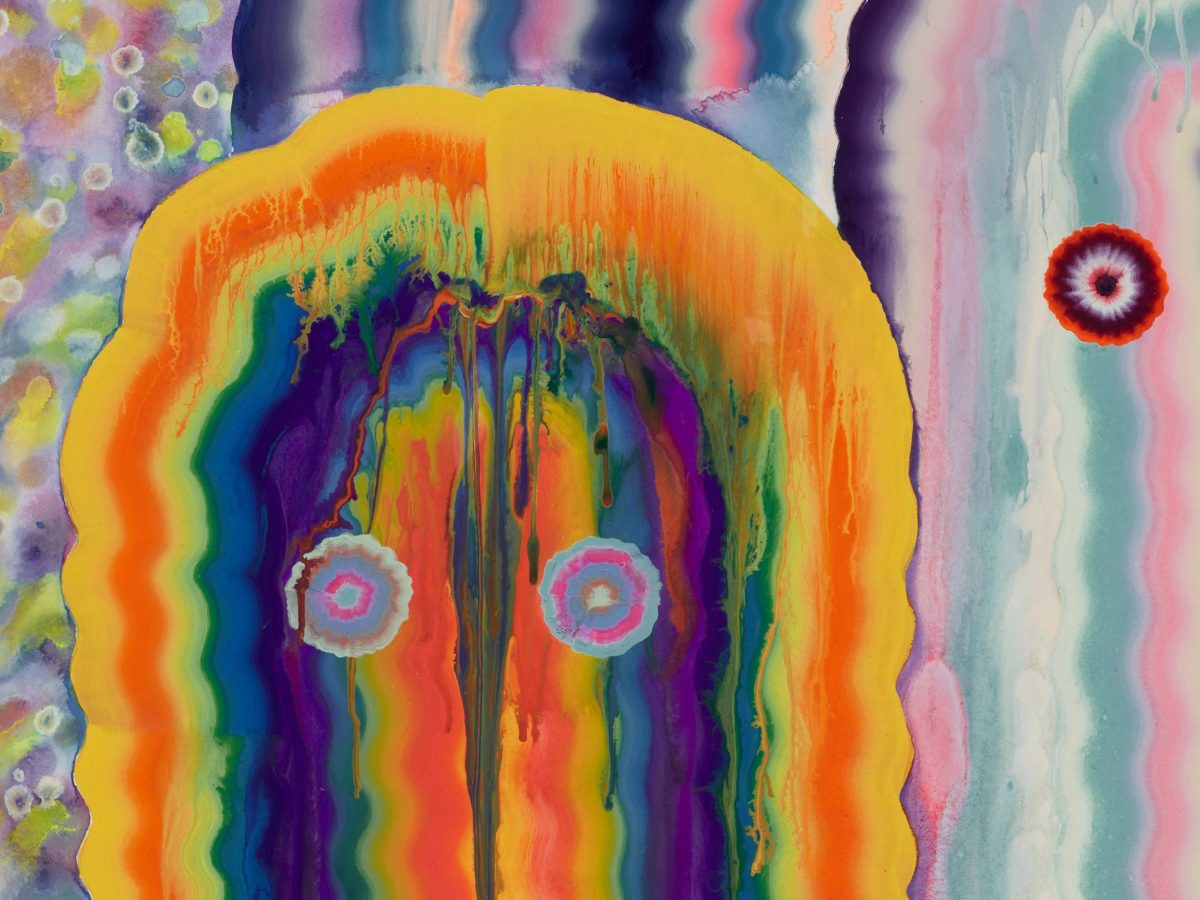[ad_1]
Inside painter Glen Baldridge‘s ninth show at NYC’s Klaus von Nichtssagend Gallery, Wigwag (on now through 11 February), mesmerizing works—featuring psychedelic creatures with piercing eyes, abstract woodland branches and kaleidoscopic acorns—posses a magnetism that must be experienced firsthand. Baldridge developed a laborious technique to execute these vibrant gouache-on-paper paintings, where the artist soaks the paper before saturating a brush with multiple colors at different densities so that the pigment passes over with various intensities. There’s chaos and control, underscored with whimsicality and inspirations from children’s books to his own backyard in Maine.

Sam Wilson, one of the three owner/directors at Klaus von Nichtssagend Gallery, tells us that Baldridge “has always been an innovative artist in terms of material and process. He has a background in printmaking and actually produced his own prints, as well as prints with other artists, for a long time.” This printmaking past, as well as the specificities of the blend roll process, informs the technique behind his current paintings.

“Each stroke is made up of three to five colors, sometimes more,” Baldridge tells us. “There’s a lot of play with how those colors meet within that one stroke—and then there’s a change when you flip the brush the other way. I often think about how color meets and how it reads differently depending on how it’s applied next to other things.”

Each work employs its own particular bleeding rainbow of color. “I’m often looking at pot paraphernalia and macrame and tie-dye for inspiration,” he continues. “There are tie-dye people on Instagram that make process videos. A lot of the language they use, where they refer to patterns and coloration, I dip into that. The ‘wigwag’ is a shifty pattern. It’s how I handle the brush and where I got the show title from.”

Each painting can take anywhere from a few days to a few weeks, depending on Baldridge’s attention at the time. The process itself informs the subject matter, especially when his lines begin to form abstract figures. “Those guys in particular kind of came out of the process and using the end of the paint in the brush. It takes a while to set up the palate and how the strokes flow, to make it apply the right way,” he says. “It’s a process of cleaning the brush out, where these ‘people’ begin to appear as waterfall-like stoner guys with flowing hair.”
His owl-like imagery, however, is an abstraction of text-based work. A careful look at each reveals the words “no way.” As Baldridge says, “I was using the circles for the center of text-based work. Things sort of emerged from those letterforms. I’ve done a lot of work investigating them. It made sense that an owl was there. And that the guys emerge from the landscape, and the acorns, as well, from playing with paint.”

It’s more of a collision of inspirations and process, however. “The ‘no way’ phrase has been a mantra repeated throughout different bodies of my work since 2016,” he continues. “When I first developed this brushstroke technique, that’s where I started, with that text laid into this intense pattern. I have a child, so I read a lot of children’s books and I live in the forest. The owls developed out of all of that. There are owls all over children’s books and they signify all different things.”

Baldridge has been working with the idea of the woods and the idea of unseen things in the forest for many years, though his earlier work is photo-based. “For about 10 years I had hunting cameras set up that were triggered by unseen things and captured photos when I wasn’t there,” he says. “I made artist books with those images, and called them Animal Selfies, as if the animals that triggered the cameras had been taking the photos of themselves.” Through other works, Baldridge continued to probe the unexplained things that happen in the woods.

As much attention is paid to the background of each painting as the subject matter. No two look the same. “I have a starting point but I don’t always have the entire painting figured out,” he says. “I try to keep it playful in that way and respond to color and see what happens. There are also unknowns with the process, the watercolor-y, wet-on-wet influence. And then there’s drying time depending on how much water is in there.”

Baldridge (who admits that he likes people to ask, “What am I looking at?”) also says that the new Klaus von Nichtssagend Gallery location informed his most recent set of paintings. “The gallery moved to Tribeca, to this big, beautiful space and it was an opportunity for me to scale up,” he says. “I got 40 by 60 watercolor paper and that was my starting point. All of these pieces were made specifically for this show.”

Prior to living and working in Maine, Baldridge lived in Brooklyn, not far from the first Klaus von Nichtssagend Gallery outpost. The move north influenced his artistic output. “I’d say that the work has gotten a lot more imaginative since moving here,” he says. “It’s more from my head and less from remote cameras, but it’s still exploring the same landscape.” Landscape, figurative or still life, Baldridge’s abstract vision is composed of—and disperses—exuberance and joy.
Hero image courtesy of Klaus Gallery
[ad_2]
Source link https://coolhunting.com/culture/interview-artist-glen-baldridge-on-the-process-behind-his-wondrous-paintings/

Leave a Reply
You must be logged in to post a comment.